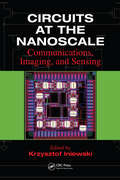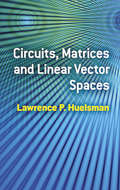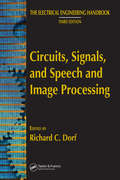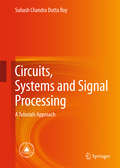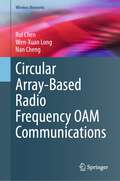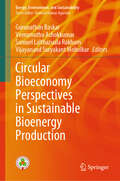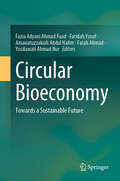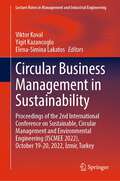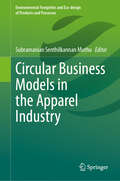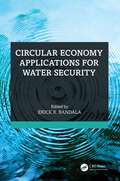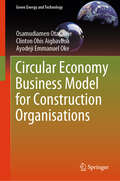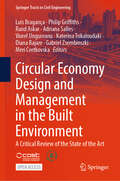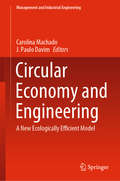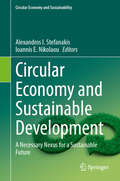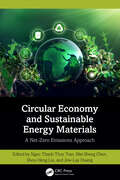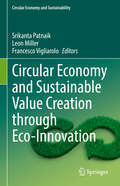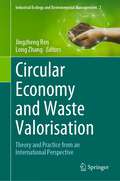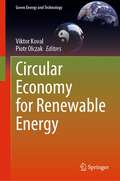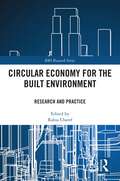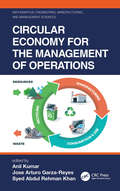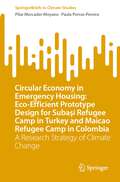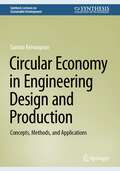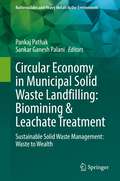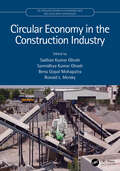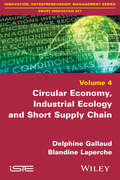- Table View
- List View
Circuits at the Nanoscale: Communications, Imaging, and Sensing (Devices, Circuits, and Systems)
by Krzysztof IniewskiCircuits for Emerging Technologies Beyond CMOS New exciting opportunities are abounding in the field of body area networks, wireless communications, data networking, and optical imaging. In response to these developments, top-notch international experts in industry and academia present Circuits at the Nanoscale: Communications, Imaging, and Sensing. This volume, unique in both its scope and its focus, addresses the state-of-the-art in integrated circuit design in the context of emerging systems. A must for anyone serious about circuit design for future technologies, this book discusses emerging materials that can take system performance beyond standard CMOS. These include Silicon on Insulator (SOI), Silicon Germanium (SiGe), and Indium Phosphide (InP). Three-dimensional CMOS integration and co-integration with Microelectromechanical (MEMS) technology and radiation sensors are described as well. Topics in the book are divided into comprehensive sections on emerging design techniques, mixed-signal CMOS circuits, circuits for communications, and circuits for imaging and sensing. Dr. Krzysztof Iniewski is a director at CMOS Emerging Technologies, Inc., a consulting company in Vancouver, British Columbia. His current research interests are in VLSI ciruits for medical applications. He has published over 100 research papers in international journals and conferences, and he holds 18 international patents granted in the United States, Canada, France, Germany, and Japan. In this volume, he has assembled the contributions of over 60 world-reknown experts who are at the top of their field in the world of circuit design, advancing the bank of knowledge for all who work in this exciting and burgeoning area.
Circuits, Matrices and Linear Vector Spaces (Dover Books on Electrical Engineering)
by Lawrence P. HuelsmanThis high-level undergraduate text explains the mathematics behind basic circuit theory. Its self-contained treatment covers matrix algebra, which provides a general means of formulating the details of a linear system. In addition, the author presents the basic theory of n-dimensional spaces and demonstrates its application to linear systems. A development of the mathematics of matrix algebra and determinants is followed by the application of matrix techniques to a general discussion of circuits. Subsequent topics include the properties of active and passive two-port devices, the basic theory of linear vector spaces, and the natural frequencies of a network. Appendixes cover the indefinite-transfer matrix, gyrators with complex gyration admittance, and network transformations. A wealth of equations and calculation problems appear throughout the text.
Circuits, Signals, and Speech and Image Processing (The Electrical Engineering Handbook)
by Richard C. DorfIn two editions spanning more than a decade, The Electrical Engineering Handbook stands as the definitive reference to the multidisciplinary field of electrical engineering. Our knowledge continues to grow, and so does the Handbook. For the third edition, it has expanded into a set of six books carefully focused on a specialized area or field of study. Each book represents a concise yet definitive collection of key concepts, models, and equations in its respective domain, thoughtfully gathered for convenient access.Circuits, Signals, and Speech and Image Processing presents all of the basic information related to electric circuits and components, analysis of circuits, the use of the Laplace transform, as well as signal, speech, and image processing using filters and algorithms. It also examines emerging areas such as text-to-speech synthesis, real-time processing, and embedded signal processing. Each article includes defining terms, references, and sources of further information.Encompassing the work of the world's foremost experts in their respective specialties, Circuits, Signals, and Speech and Image Processing features the latest developments, the broadest scope of coverage, and new material on biometrics.
Circuits, Systems and Signal Processing: A Tutorials Approach
by Suhash Chandra Dutta RoyThis book is a collection of tutorial-like chapters on all core topics of signals and systems and the electronic circuits. All the topics dealt with in the book are parts of the core syllabi of standard programs in Electrical Engineering, Electrical and Computer Engineering, and Electronics and Telecommunication Engineering domains. This book is intended to serve as a secondary reader or supplementary text for core courses in the area of signals and systems, electronic circuits, and analog and digital signal processing. When studying or teaching a particular topic, the students and instructors of such courses would find it interesting and worthwhile to study the related tutorial chapter in this book in order to enhance their understanding of the fundamentals, simplification of procedures, alternative approaches and relation to other associated topics. In addition, the book can also be used as a primary or secondary text in short-term or refresher courses, and as a self-study guide for professionals wishing to gain a comprehensive review of the signals and systems domain.
Circular Array-Based Radio Frequency OAM Communications (Wireless Networks)
by Nan Cheng Rui Chen Wen-Xuan LongThis book presents the modeling and transmission theory of RF OAM communications. The book features the UCA-based RF point-to-point OAM communication system, the UCA-based RF point-to-multipoint OAM wireless backhaul network, the HCCL structure for long-distance OAM transmissions, and the UCA-based joint OAM RadCom scheme. For the UCA-based RF point-to-point OAM communication system, a 2-D ESPRIT-based distance and AoA estimation method is first introduced, followed by an OAM reception scheme including the hybrid mechanical and electronic beam steering with the estimated AoA and the amplitude detection with the estimated distance. The proposed RF OAM communication scheme is extended to the RF OAM-MIMO system equipped with UCCAs. For the UCA-based RF point-to-multipoint OAM wireless backhaul network, an OAM-based multi-user distance and AoA estimation method is introduced, followed by a multi-user OAM preprocessing scheme. At last, the proposed methods are extended to the downlink multi-user OAM-MIMO wireless backhaul system equipped with UCCAs. Moreover, a novel HCCL structure is introduced to realize long-distance OAM transmission. For the UCA-based joint OAM RadCom scheme, an OAM-based 3-D super-resolution position estimation and rotation velocity detection method is introduced, and then the PCRB of the OAM-based estimates and the transmission rate of the integrated system are derived and analyzed. To achieve the best performance trade-off, the transmitted integrated OAM beams is optimized by means of an exhaustive search method. Finally, this book discusses future research directions to inspire further investigation in the field of RF OAM communications from different perspectives.
Circular Bioeconomy Perspectives in Sustainable Bioenergy Production (Energy, Environment, and Sustainability)
by Samuel Lalthazuala Rokhum Vijayanand Suryakant Moholkar Gurunathan Baskar Veeramuthu AshokkumarThis book covers the various technological developments and challenges in converting biomass residues into different forms of bioenergy. The continuous increase in the world population increased the demand for food products. The incorporation of modern technologies in agriculture increased the production of various food products, ending with excess generation of agricultural biomass residues from primary and secondary agriculture industries. Since, these biomass residues are a rich source of valuable bioproducts, they can be converted into various forms of bioenergy, such as biogas, biochar, biooil, biodiesel, and bioethanol. Besides, this approach is expected to address the gaps in biomass residue management and transformation to valuable bioproducts, and it also enhances the circular economy perspective. The book can be a valuable reference for beginners, researchers, and professionals interested in sustainable construction and allied fields.
Circular Bioeconomy: Towards a Sustainable Future
by Farah Ahmad Fazia Adyani Ahmad Fuad Faridah Yusof Amanatuzzakiah Abdul Halim Yusilawati Ahmad NorThis book highlights the efforts made to realize the concept of ‘Circular Bioeconomy’. It has twelve (12) chapters, focussed on five (5) sections, namely Biomaterials, Environment, Energy, Pharmaceutical and Enzyme Technology. It portrays research, linking ‘Circular Bioeconomy’ to the United Nation’s Sustainable Development Goals (SDGs). The concept of ‘Circular Economy’, including ‘Circular Bioeconomy’, aims to shift the current, essentially linear economic system to a more sustainable one. Accordingly, the key goal of a ‘Circular Economy’ is to slow, narrow and close material resource loops, built on the foundation of renewable energy and non-toxic materials. Further, a sustainable ‘Bioeconomy’ goes beyond simply switching fossil resources with renewable, biological resources. It requires low-carbon energy inputs, sustainable supply chains and promising disruptive conversion technologies for the sustainable transformation of renewable bioresources to high-value bio-based products, materials and fuels. Thus, a sustainable ‘Circular Bioeconomy’ transition will necessitate a set of consistent metrics that fit all products and industries.
Circular Business Management in Sustainability: Proceedings of the 2nd International Conference on Sustainable, Circular Management and Environmental Engineering (ISCMEE 2022), October 19–20, 2022, İzmir, Turkey (Lecture Notes in Management and Industrial Engineering)
by Viktor Koval Yigit Kazancoglu Elena-Simina LakatosThis book gathers research and best-practices concerning the achievement of sustainable development goals in both community generation and business growth. It highlights the organizational aspects relating to the realization of green innovation. It covers models for optimizing the use of both natural and human resources. It reports on assessment methods and advanced models to analyze community and business performance in the context of sustainable development. Further, it proposes solutions to reduce the effects of environmental pollution, increase energy efficiency, and managing resources and waste, to foster sustainable development. Gathering the proceedings of the 2nd International Conference on Sustainable, Circular Management and Environmental Engineering (ISCMEE 2022), held on October 19-20, 2022, as a hybrid event from İzmir, Turkey, this book offers a timely snapshot on circular business management knowledge and methods for both researchers and professionals in the field of engineering management, business and economics, and energy and environment.
Circular Business Models in the Apparel Industry (Environmental Footprints and Eco-design of Products and Processes)
by Subramanian Senthilkannan MuthuThis volume offers a variety of cases dealing with circular business models in the textile and fashion industry. The cases cover the circularity, circular business models relevant to the apparel industry. In addition, this book presents a comprehensive examination of circular economy principles within the textile and apparel industry, emphasizing sustainability and innovation through various lenses.
Circular Economy Applications for Water Security
by Erick R. BandalaIn arid and semi-arid regions, where water demand exceeds water availability, water security is becoming a significant concern not only related to water availability but also to rigorous and costly requirements to remove conventional and emerging contaminants from effluents discharging into drinking water sources or as water reuse becomes an alternate water supply for communities in these regions. Water and wastewater treatment demands a great amount of energy and resources, highlighting the need for novel applications of the circular economy concept. Circular Economy Applications for Water Security examines knowledge gaps, avenues of future research, and challenges related to the potential of enhanced underutilized/waste materials as a transition to circular economy applications for ensuring the proper quality of water. This book includes fundamental information and practical examples that helps to better understand the concepts included. The circular economy concept is helpful to incept sustainability in the water treatment processes. Every chapter includes the identification of knowledge gaps, avenues for further research, and challenges that guide readers towards real state-of-the-art analysis. Contributors are experts in their areas and will commit to explaining concepts in a user-friendly way without missing scientific rigor.
Circular Economy Business Model for Construction Organisations (Green Energy and Technology)
by Clinton Ohis Aigbavboa Osamudiamen Otasowie Ayodeji Emmanuel OkeThis book takes readers through the process of integrating the circular economy into the business model of construction organizations. It offers not only theory but also a workable implementation plan. This approach guarantees that readers can implement these insights into their construction operations with confidence. It includes in-depth analyses of the circular economy business model and the peculiarities of the construction sector, providing an approach that considers both the opportunities and challenges faced by this sector. In addition, it shows how the circular economy framework can continue to be relevant and adaptable by addressing the current adoption level of the circular economy in construction and preparing readers for new developments. Lastly, the book demonstrates how circular value propositions can be used to implement the circular economy in the construction sector, thus increasing revenue and profits in construction.
Circular Economy Design and Management in the Built Environment: A Critical Review of the State of the Art (Springer Tracts in Civil Engineering)
by Viorel Ungureanu Luís Bragança Meri Cvetkovska Rand Askar Philip Griffiths Adriana Salles Katerina Tsikaloudaki Diana Bajare Gabriel ZsembinszkiThis open access book offers a comprehensive exploration of Circular Economy Design and Management within the Built Environment, presenting a critical review of the current state of the art. Going through multi-level approaches from material usage to urban planning, it meticulously examines strategies for circular building design, criteria, and indicators for circularity. Additionally, it explores practical tools and frameworks, as well as roles and relationships of stakeholders along the entire value chain. Through insightful case studies and critical analysis, readers gain a deep understanding of circularity principles and applications, circularity management models and feedback systems, sustainable practices, and the integration of circularity into technological advancements and digital tools such as BIM. The importance of this book lies in addressing pressing challenges in contemporary architecture and construction, providing a roadmap for sustainable, circular solutions. It tackles the critical need to transition from linear to circular practices, emphasising resource efficiency, waste reduction, and the longevity of structures. By offering practical insights and highlighting successful implementations, the book aims to guide architects, civil engineers, designers, sustainability professionals, and policymakers towards informed decision-making in creating environmentally conscious built environments. Designed for these professionals and researchers, this book serves as a valuable resource for anyone passionate about reshaping the future of our built spaces with a focus on circularity and environmental responsibility.
Circular Economy and Engineering: A New Ecologically Efficient Model (Management and Industrial Engineering)
by J. Paulo Davim Carolina MachadoThis book provides support to academics and researchers, as well as those operating in the management and engineering fields that need to deal with policies and strategies that allow to move towards a more sustainable paradigm, a greener economy that guarantees economic development and the improvement of living and working conditions. Drawing on the latest developments, ideas, research and best practice, this book examines the new advances in the subjects of circular economy.
Circular Economy and Sustainable Development: A Necessary Nexus for a Sustainable Future (Circular Economy and Sustainability)
by Alexandros I. Stefanakis Ioannis E. NikolaouThis book will highlight the role of CE in the sustainability field as it is expressed in the various fields and disciplines and its contribution to building a sustainable society by providing a better understanding of the relevant social and cultural structures and the need for cross-disciplinary knowledge and diverse skills. Such an integrated approach which combines the concept of sustainability in the engineering field to create a CE, has not yet been presented in detail in the published literature, and there are only scattered studies covering only small parts of this holistic approach. Hence, this book will represent a single reference that will provide summarized information and state-of-the-art knowledge on this topic of the future. The book will include chapters showcasing/investigating the relation between circular economy principles and their realization in different engineering fields. This includes theoretical justification, research studies and full-scale case studies. The approach focuses on two distinct levels: macro and micro, on both production and consumption sides.
Circular Economy and Sustainable Energy Materials: A Net-Zero Emissions Approach
by Ngoc Thanh Thuy Tran Jow-Lay Huang Wei-Sheng Chen Shou-Heng LiuAchieving carbon neutrality is crucial for creating a sustainable and resilient future worldwide. The circular economy framework focuses on reducing waste, optimizing resource use, and promoting regenerative practices, thus curbing carbon footprints. Concurrently, sustainable energy techniques, such as harnessing renewable sources, enhancing energy storage, and boosting energy efficiency, contribute to the reduction of greenhouse gas emissions. With a unique emphasis on net-zero emission approaches, this book delves into circular economy principles and sustainable energy materials, offering a comprehensive perspective on climate change challenges. Covers fundamental circular economy principles, from carbon capture to advancements in biomass and hydrogen energy Explores recycling techniques for essential energy materials, including batteries, solar cells, and fuel cells Provides detailed coverage of technologies, processes, and challenges related to achieving sustainability in the energy sector Bridges theory and practical applications Offering a roadmap toward a carbon neutral and net-zero emission future, this book serves as a valuable resource for advanced students, researchers, engineers, and policymakers worldwide seeking solutions to climate change and sustainable development.
Circular Economy and Sustainable Value Creation through Eco-Innovation (Circular Economy and Sustainability)
by Srikanta Patnaik Francesco Vigliarolo Leon MillerCircular economy and sustainable value creation through eco-innovation are interconnected concepts that revolve around creating a more sustainable and environmentally friendly approach to economic growth and business development. In a world confronted by pressing environmental challenges, the need for sustainable economic practices has never been more urgent. The traditional linear economic model, characterized by the "take-make-dispose" approach, has led to resource depletion, environmental degradation, and social inequalities. In response to these challenges, the concepts of circular economy and eco-innovation have emerged as powerful frameworks for reshaping our economic systems to prioritize sustainability. The circular economy represents a paradigm shift from the linear economic model that has dominated for centuries. Instead of viewing resources as finite and disposable, the circular economy embraces the idea that resources can be kept in circulation for as long as possible, thereby minimizing waste and environmental impact. At the core of the circular economy is the efficient use of resources. This entails reducing resource consumption, reusing products and materials, and recycling to extend the life of resources. Products are designed with durability and ease of repair in mind, ensuring they have a longer lifespan and can be easily maintained. Circular practices aim to restore natural systems and reduce harm to the environment, whether through reforestation, soil regeneration, or sustainable agriculture.
Circular Economy and Waste Valorisation: Theory and Practice from an International Perspective (Industrial Ecology and Environmental Management #2)
by Jingzheng Ren Long ZhangThe authors and editors of this volume state that with the intensive growth of global industrialization and urbanization, the consumption of various resources and materials, such as energy, minerals, and even water, is increasing at an amazing speed, which poses great pressure on material resources. In addition, the massive utilization of materials has led to low efficiency, resulting in great wastes of resources as well as serious environmental pollutions and degradation, which has severely hindered the sustainable development of economy and society. In order to transit to sustainable development, it is necessary to improved resource efficiency, and circular economy and waste valorization are the best alternative ways for achieving this goal. This book aims to provide an in-depth description of circular economy and waste valorization, make assessments for circular economy and waste valorization in different regions and countries and determine the technological pathways and roadmap for achieving circular economy and waste valorization. More specifically: (1) Conceptions and Theories: Concepts and definitions of circular economy and waste valorization and their nexus and contributions to sustainable development. (2) Policy and Practice: Measurement and assessment of performance or sustainability for implementing circular economy and waste valorization. (3) Pathways and Prospects: Identification and prioritization of the barriers, strategies, technologies, and pathways for achieving circular economy and waste valorization. The book systematically and comprehensively introduces the definitions, concepts, framework and nexus of circular economy and waste valorization, analyzes and measures their performance and sustainability and provides the methods for investigating and prioritizing the barriers and strategies and determining the pathways and roadmap for their development.
Circular Economy for Renewable Energy (Green Energy and Technology)
by Viktor Koval Piotr OlczakThis book explores the role of renewable energy sources in driving sustainable development, with a focus on their circular use in achieving environmental efficiency and an energy balance. The authors highlights the significance of renewable energy in reducing costs for producers and consumers while also ensuring the production of clean energy that can be integrated seamlessly into the national power grid without compromising reliability or energy security.Readers are introduced to the circular economy model and its importance in the context of renewable energy. The book sheds light on the challenges associated with transitioning to alternative energy systems, particularly in cases where not all resources can be fully circulated. Through the research presented in this book, stakeholders will gain insights into how the sustainable renewable energy supply chain can be adapted within the circular economy. This will have a synergistic effect in reducing carbon emissions, and also aid in the production of renewable energy equipment.
Circular Economy for the Built Environment: Research and Practice (ISSN)
by Rabia CharefThis book provides an overview of the circular economy in the built environment, presenting a fusion of insights from esteemed researchers and seasoned practitioners. The chapters cover pivotal themes, including the transformative concept of buildings as material banks, innovative design approaches, and the potential of digitalization for a circular built environment. Beyond these foundational themes, the book critically addresses the integration of low-tech solutions and some principles of sobriety in the built environment. It also takes an informed look at the role of standardization, providing nuanced insights into its driving influence on circular practices and the associated challenges and opportunities.The book adopts a trans-scalar perspective by traversing the entire spectrum of building phases from initial programming to the recovery phase, as well as from the scale of materials to the scale of buildings, offering a profound examination of the intricate dynamics involved in the offer/demand for recovered materials. This book highlights the paramount need to harmonize research with practical applications. By spotlighting effective circular practices and elucidating the challenges faced by practitioners, it identifies fertile grounds for further research. Moreover, the book extends its reach by offering practical ideas on how practitioners can seamlessly adopt a circular approach in both thought and realization.Circular Economy for the Built Environment: Research and Practice is a must-read book for students, researchers, academics, and practitioners in the fields of architecture, planning, engineering, construction, and real estate. This book provides a compelling narrative that bridges the theoretical and practical realms of the circular economy in the built environment.
Circular Economy for the Management of Operations (Mathematical Engineering, Manufacturing, and Management Sciences)
by Anil Kumar Syed Abdul Rehman Khan Jose Arturo Garza-ReyesCircular-Economy is a new concept in operations management. Its goal is to redefine growth, focusing on positive benefits arising for society as a whole out of efficiencies such as designing waste out the operations process. This book will help practitioners use the proper strategy for effective adoption of Circular practices to use in their organization. Features: Provides a complete understanding of Circular-Economy practices Offers advanced mathematical models to help industry management adopt the correct practices Presents a deep understanding of cross-functional and customer-focused design thinking Covers how to develop sustainable practices in all types of activities within operations management. Circular Economy for the Management of Operations will be of interest to practitioners and researchers in engineering as well as business management
Circular Economy in Emergency Housing: A Research Strategy of Climate Change (SpringerBriefs in Climate Studies)
by Pilar Mercader-Moyano Paula Porras-PereiraIn recent years, there has been an upsurge in the number of forced displacements due to natural disasters, armed conflicts, and pandemics, which has favoured an increase in the number of temporary accommodations. Although the provision of shelter after an emergency situation is one of the priorities of humanitarian aid, the reality is that the conditions in which people live in a situation of forced displacement are absolutely precarious and overcrowded. Nowadays, this type of housing tends to have a short lifespan, deepening the environmental impact and the generation of waste. Likewise, added to this great problem is the linear economic system implemented worldwide, which also causes a high rate of waste.This investigation develops an eco-efficient design protocol that determines the basic premises in any emergency situation, therefore avoiding the precarious nature to which those in forced displacement are exposed. Moreover, the research investigates different constructive solutions that can respond to situations of natural catastrophes or humanitarian disasters where emergency housing is needed as well as the possible alternatives from the point of view of circular economy. Eco-efficient and environmentally correct solutions are sought, which can be adaptable to the different scenarios where emergency housing may be needed, thus creating a rapid, easy, functional, and environmentally correct architecture, adaptable to these types of situations. The study shows that the factors that characterize emergency architecture can be an example of where the issues around the sustainability factor are applied in a practical way. The main objectives of this study are to develop an eco-efficient design protocol which determines the basic premises in any emergency situation and to find eco-efficient and environmentally correct solutions, adaptable to different scenarios, which have similar climatic characteristics, and where emergency housing may be needed, thus creating a type of ephemeral architecture but sensitive to the user to whom it is intended and in accordance with the optimal conditions of habitability.
Circular Economy in Engineering Design and Production: Concepts, Methods, and Applications (Synthesis Lectures on Sustainable Development)
by Samira KeivanpourThis concise text provides the concepts, methods, and application examples for integrating sustainability into engineering design and production. It discusses the role of sustainability in the value creation processes of various enterprises and different tools and methods for systematic incorporation of social and environmental aspects into the product's life cycle. The following topics are covered: sustainable development in engineering systems and the life cycle concept, norms and standards in the sustainable development and integration of socio-economic assessment into technical valuation, production systems, management of the production systems based on circular economy principles, ecodesign practices, and value creation and innovative design in the circular economy. Provides a concise guide for engineering students for applying circular economy practicesPresents examples and short case studies for understanding the methods and toolsFacilitates understanding and application of the life cycle perspective in product manufacturing and green engineering
Circular Economy in Municipal Solid Waste Landfilling: Sustainable Solid Waste Management: Waste to Wealth (Radionuclides and Heavy Metals in the Environment)
by Pankaj Pathak Sankar Ganesh PalaniThis book will serve as a ready reckoner of contemporary information regarding municipal solid waste landfill biomining, treatment of landfill leachate and heavy metals in a single platform. The academicians, researchers, and students at master’s and doctoral levels will be able to understand the current trends in municipal solid waste landfill operations, which will help in augmenting their research. Construction of new landfills requires huge monetary investments, which can be avoided if old landfills were bio-mined for resources and the space can be re-used as new landfills. Landfill leachate is a hazardous waste which needs proper treatment that could generate value-added products such as clean energy and biofertilizers. In this book, each chapter would provide the background, methodology, and relevant calculations for sustaining landfill operations. Also, the case studies based on best practices in municipal solid waste landfilling are discussed in this book.
Circular Economy in the Construction Industry (The Circular Economy in Sustainable Solid and Liquid Waste Management)
by Sadhan Kumar Ghosh Sannidhya Kumar Ghosh Benu Gopal Mohapatra Ronald L. MerskyCircular Economy in the Construction Industry is an invaluable resource for researchers, policymakers, implementers and PhD and Masters-level students in universities analyzing the present status of Construction and Demolition Wastes (C&DW) management, materials development utilizing slag, fly ash, HDPE fibre, geo-wastes, and other wastes, green concrete, soil stabilization, resource circulation in construction sectors, success in experimentation & commercial production, future needs, and future research areas. While huge C&DW is wasted by dumping, there is potential of recycling preventing greenhouse gas (GHG) emissions and environmental pollution as well as creating business opportunities. Circularity of resources in the construction industry can contribute to a more secure, sustainable, and economically sound future through proper policy instruments, management systems, and recycling by selecting the following: Supply chain sustainability and collection of C&D Wastes, Appropriate separation and recycling technology, Enforcement of policy instruments, Productivity, quality control of recycled products and intended end use, Economic feasibility as business case, commercialization, generating employment. This book addresses most of the above issues in a lucid manner by experts in the field from different countries, which are helpful for the related stakeholders, edited by experts in the field.
Circular Economy, Industrial Ecology and Short Supply Chain: Towards Sustainable Territories
by Blandine Laperche Delphine GallaudIn contrast to the linear "take-make-dispose" model of resource consumption, a new industrial model is proposed in the form of a circular economy. This model aims to optimize the use of resources and to reduce or eliminate waste, and is based on re-use, repair, ecodesign, industrial ecology, sustainable supply and responsible consumption. Industrial ecology and short supply chains can contribute - particularly on a territorial scale - to the emergence of a real sustainable development. This book develops these concepts and presents experiments that are taking place in France and other countries, in addition to an integrated model which details the mechanisms through which industrial ecology and short supply chains can generate economic, social and environmental profits. The possible issues and obstacles facing these new practices are also analyzed, in order to develop the outline of an adapted management and governance which will enable them to be fully realized.
